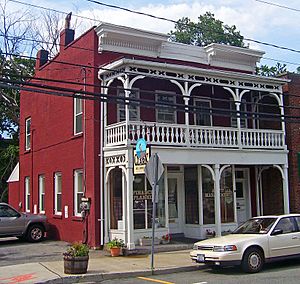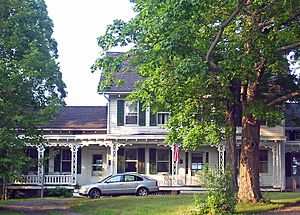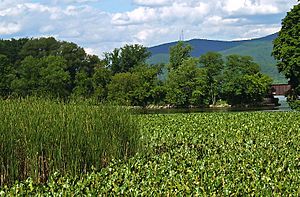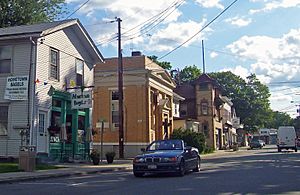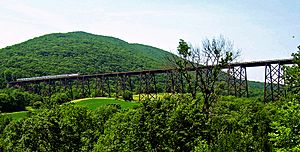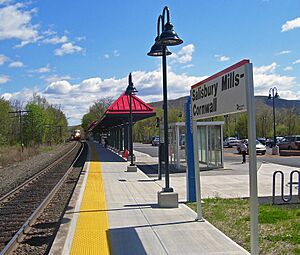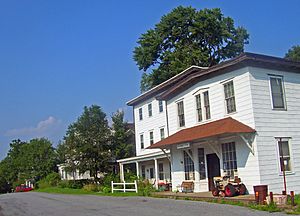Cornwall, New York facts for kids
Quick facts for kids
Cornwall
|
|
|---|---|

Town hall
|
|
| Etymology: from Cornwall, England | |
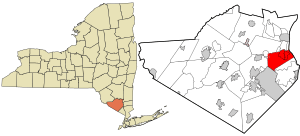
Location in Orange County and the state of New York.
|
|
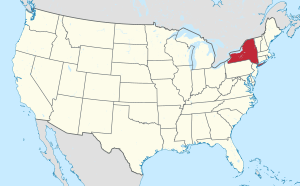
Location of New York in the United States
|
|
| Country | United States |
| State | New York |
| County | Orange |
| Founded | 1685 |
| Area | |
| • Total | 28.13 sq mi (72.86 km2) |
| • Land | 26.65 sq mi (69.03 km2) |
| • Water | 1.48 sq mi (3.83 km2) |
| Elevation | 240 ft (70 m) |
| Highest elevation
(Southwestern town line, on Schunemunk Mountain)
|
1,540 ft (470 m) |
| Population
(2020)
|
|
| • Total | 12,884 |
| • Density | 468.24/sq mi (180.79/km2) |
| Time zone | UTC-5 (Eastern (EST)) |
| • Summer (DST) | UTC-4 (EDT) |
| ZIP Code |
12518, 12520
|
| Area code(s) | 845 |
| FIPS code | 36-071-18300 |
| FIPS code | 36-18300 |
| GNIS feature ID | 0978869 |
| Wikimedia Commons | Cornwall, New York |
| Website | www.cornwallny.com |
Cornwall is a town in Orange County, New York. It's about 50 miles (80 km) north of New York City. The town sits on the western side of the Hudson River. In 2020, about 12,884 people lived there. Cornwall is a popular place for people who work in nearby cities, including New York City. You can take a train to North Jersey and New York City from the Salisbury Mills–Cornwall train station. Major roads like the New York State Thruway are also easy to reach.
Cornwall's Main Street has many shops, restaurants, and cafes. You'll also find government offices, churches, parks, and a hospital nearby. The town is known for its many trees and is a designated Tree City. In 2013, Bloomberg Business Week magazine named Cornwall one of "The Best Places to Raise Kids" in New York State.
Contents
New Buildings and Upgrades
Cornwall has seen many improvements to its buildings and services. Here are some of the changes from recent years:
- A new town hall was built on Main Street in 1997. It replaced an older building from 1872. The new hall has a clock tower and offices.
- The Cornwall Public Library was made bigger and better in 2001. It now has more space for books, computers, and activities.
- A new water treatment plant was finished in 2005. It helps keep the water clean for everyone.
- Solar panels were put on the roof of Cornwall Central High School in 2012. This helps the school use clean, solar energy.
- A new bridge was built over Moodna Creek on Route 94 in 2018.
Schools in Cornwall
Cornwall has a public school district for about 3,000 students. It includes four schools:
- Cornwall Elementary School
- Willow Avenue Elementary School
- Cornwall Central Middle School
- Cornwall Central High School
The district offers many different classes and after-school activities.
There are also two private schools in Cornwall:
- New York Military Academy (NYMA) is a school for boys and girls in grades 7-12. It teaches leadership and strong academics. NYMA started in 1889. Famous people like Donald Trump and Stephen Sondheim went there.
- Storm King School is a school for boys and girls in grades 8-12. It prepares students for college. The school focuses on arts, sciences, and being a global citizen. Storm King School was founded in 1867.
Arts and Fun in Cornwall
Cornwall has a rich history and many fun places to visit:
- The Cornwall Historical Society Museum
- The Hudson Highlands Nature Museum
- The annual RiverFest
- The Cornwall Fall Festival
- The Storm King Art Center
Cornwall's Past
When explorer Henry Hudson visited in 1609, the Waoraneck Native Americans lived here. In 1685, about 25 Scottish families settled near the Moodna Creek. They were led by Major Patrick McGregor. Over the next 50 years, more English and Scottish families arrived. They named the area "new Cornwall" because it looked like County Cornwall, England. The first town meeting was held in 1765. In 1788, the area became the town of "New Cornwall." Its name was changed to "Cornwall" in 1797.
In the late 1800s, Cornwall became a popular summer resort. People loved its beautiful river, mountain views, fresh air, and easy travel from New York City by boat or train.
The 1800s and Health Retreats
In the mid-1800s, Cornwall became known as a place for health and wellness. People from the city came to enjoy the fresh air and forests. They believed the natural setting helped them feel better. Cornwall offered many places to stay and was easy to reach by railroad and steamboat.
Nathaniel Parker Willis, a famous writer, loved Cornwall so much that he bought a home here called Idlewild. His writings helped make Cornwall a popular spot. Winslow Homer, a well-known watercolor artist, spent summers in Mountainville. Many of his paintings show the local scenery.
People also started enjoying outdoor activities like hiking, rowing, and fishing. This led to the growth of summer camps and the idea of summer vacations.
Old Buildings with Stories
Cornwall has several historic buildings that tell stories about its past:
- The A. J. Clark Store is on Main Street. It was built around 1875 as a butcher shop. It's now listed on the National Register of Historic Places.
- The Canterbury Presbyterian Church is on Clinton Street. This white stone and brick building was built in the Federal style. It's also on the National Register of Historic Places. In 2018, it became a dance studio, which helped fix up the old building.
- The Carvey–Gatfield House is a stone house on Angola Road. It was built in the early 1800s. It stayed in the same family for almost 100 years.
- The Oliver Brewster House is a Gothic Revival home on Willow Avenue. It started as a farmhouse in the mid-1800s. Later, it became a boardinghouse for summer visitors.
- The Samuel Brooks House is north of Mountainville. Samuel Brooks built it as a farmhouse around 1860. It also became a popular boardinghouse for summer guests.
Protecting Nature
In 1962, a big legal fight started that changed how we protect our environment. A company wanted to build a large power plant on Storm King Mountain near Cornwall. Local people fought against it.
After many years, a court decided that protecting nature was just as important as making money. This was a huge step! It led to a new law in 1969 called the National Environmental Policy Act. This law makes sure that big projects are studied to see how they might affect the environment.
Where is Cornwall?

Cornwall is about 52 miles (84 km) north of New York City. It's also about 5 miles (8 km) north of the United States Military Academy at West Point. The town covers about 28.2 square miles (73 km²). Most of it is land, with some water.
Cornwall has many different types of land. It has valleys formed by Moodna and Woodbury creeks. There are also wet areas called estuarine salt marshes. You'll find developed areas, farms, and rocky hills. Two large protected areas are mostly within the town: Storm King State Park and Black Rock Forest.
The flattest part of Cornwall is in the northeast, near the river. Here you'll find the village of Cornwall-on-Hudson. To its west is another living area called Firthcliffe. Most of Cornwall's people live in these areas.
South of Cornwall-on-Hudson, the land rises to Deer Hill and then to Storm King Mountain. The town's southern border runs through Storm King State Park and most of Black Rock Forest. This area is very hilly and rugged.
Further west, you'll find the small village of Mountainville. It's named after Schunemunk Mountain, which is the highest point in town at 1,540 feet (469 m).
Near Salisbury Mills, you can see the Moodna Viaduct. This is the tallest and longest railroad bridge east of the Mississippi River. It was even shown in the 2007 movie Michael Clayton. NY 94 also runs through this part of town.
Cornwall used to have more passenger trains. Until 1953, trains ran from the Catskills to Weehawken. Until 1958, trains from Albany passed through Cornwall to Weehawken.
Places in Cornwall
Here are some of the communities and important places in Cornwall:
- Beaver Dam Lake – a small community in the northwest.
- Beaverdam Lake – a lake surrounded by the Beaver Dam Lake community.
- Black Rock Forest – a forest with trails and an education center.
- Cornwall-on-Hudson – a village in the eastern part of town.
- Firthcliffe – a community west of Cornwall-on-Hudson.
- Firthcliffe Heights – a community near the northern town line.
- Meadowbrook – a community west of Cornwall-on-Hudson.
- Mountainville – a community in the western part of town.
- New York Military Academy – a military school.
- Orrs Mill – a community south of Firthcliffe.
- Salisbury Mills – a community partly in Cornwall.
- Storm King State Park – a state park by the Hudson River.
- West Cornwall – a community south of Firthcliffe.
- Museum of the Hudson Highlands – a park and museum.
- Storm King Art Center – an outdoor art museum in Mountainville.
Population of Cornwall
| Historical population | |||
|---|---|---|---|
| Census | Pop. | %± | |
| 1790 | 4,225 | — | |
| 1800 | 1,648 | −61.0% | |
| 1810 | 1,769 | 7.3% | |
| 1820 | 3,020 | 70.7% | |
| 1830 | 3,486 | 15.4% | |
| 1840 | 3,925 | 12.6% | |
| 1850 | 4,471 | 13.9% | |
| 1860 | 4,800 | 7.4% | |
| 1870 | 5,989 | 24.8% | |
| 1880 | 3,833 | −36.0% | |
| 1890 | 3,766 | −1.7% | |
| 1900 | 4,258 | 13.1% | |
| 1910 | 5,690 | 33.6% | |
| 1920 | 4,259 | −25.1% | |
| 1930 | 5,067 | 19.0% | |
| 1940 | 5,299 | 4.6% | |
| 1950 | 6,154 | 16.1% | |
| 1960 | 8,094 | 31.5% | |
| 1970 | 9,672 | 19.5% | |
| 1980 | 10,774 | 11.4% | |
| 1990 | 11,270 | 4.6% | |
| 2000 | 12,307 | 9.2% | |
| 2010 | 12,646 | 2.8% | |
| 2020 | 12,884 | 1.9% | |
| U.S. Decennial Census | |||
In 2020, Cornwall had a population of 12,884 people. The town has grown steadily over the years. In 2000, there were 12,307 people living in Cornwall. About 37% of households had children under 18. The average age in town was 38 years old.
Famous People from Cornwall
Many notable people have connections to Cornwall:
- Hannah Johnston Bailey (born 1839) – An activist for women's right to vote and peace.
- Bonnie Blair (born 1964) – An Olympic speed skater.
- Rob Cohen (born 1949) – A movie director and producer.
- David Petraeus – A four-star general who graduated from Cornwall Central High School in 1970.
- Whit Stillman (born 1952) – An Academy Award–nominated writer and director who grew up in Cornwall.
- Shea Farrell – An actor and producer.
- Nathaniel Parker Willis – An American author who lived in Cornwall at his home called Idlewild.
- Armand Assante – An actor who was raised in Cornwall.
- Larry David and Richard Lewis – Famous comedians who first met at a camp in Cornwall-on-Hudson when they were 13.
See also
 In Spanish: Cornwall (Nueva York) para niños
In Spanish: Cornwall (Nueva York) para niños


